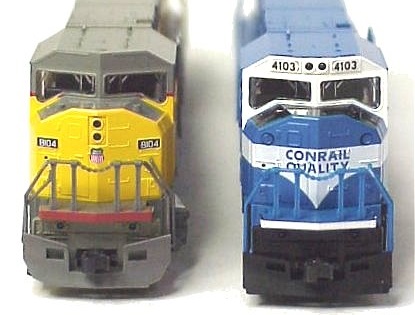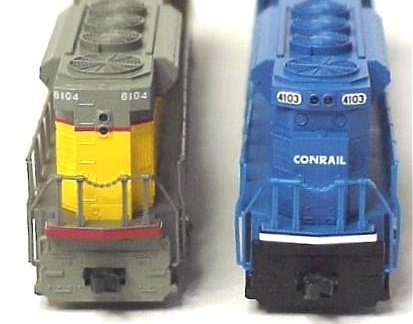Introduced: 2001 (DCC-Ready Version) and 2025 (DCC Versions)
These two models are virtually identical, with the differences between the two basically boiling down to minor variations in the shell detailing (see below).
These models employ all of the time-honored design features one normally associates with "modern" Kato diesels - shell-mounted knuckle couplers, split-frame DCC-Ready metal chassis, dual-flywheels, low-friction drive, plastic truck assemblies, plastic gearing, blackened wheels, all-wheel drive, and all-wheel pick-up (no traction tires). The motor is an open-sided 5-poler. Directional lighting is provided by a PC board mounted on top of the chassis (white LEDs). Wheels are low-profile and have no problems on Code-55 track.
Performance is perfect in every way - smooth, quiet, flawless pickup and throttle response, great pulling power, no problems on narrow radius curves, etc.
The only differences between the SD80 and SD9043MAC's are on the front and back -


As noted above, Kato released DCC-equipped versions (sound and non-sound) of their SD80MAC's in 2025. Unfortunately, their website doesn't actually say what type of decoders were used and I'm not willing to shell out hundreds of dollars to find out for myself.
Shell Removal -
Shell removal is pretty simple - just take hold of the fuel tank with one hand and the shell with the other, then just sort of wiggle the shell up and off.
Grade: A (both)
Reviewed: 9/01 Model Railroader- "Like the real things, the very first thing you notice about Kato's new N scale SD80 and '90MACs is the size - these are big engines. Even in N scale the locomotive achieves a presence normally found only in larger scales. Combine this presence with an outstanding mechanism, excellent tooling, and accurate paint and lettering and you have a locomotive that N scalers will stand up and notice... The Kato models capture the differences between the SD80 and SD90 in a way that would have been unheard of in N scale motive power just a few years ago. Comparing the models to plans of the SD80MAC and the SD90MAC reveals that the models matched all significant dimensions. The modelwork is outstanding. You can see the fan blades inside the roof intakes, and the cab window frames are sharply molded, but I was especially impressed with the truck sideframes. These locomotives ride on EMD's latest radial self-steering truck and, with its 45" wheels and 82" axle spacing, the HTCR-II is visibly different than earlier trucks. The model's trucks are beauties, with lots of depth and every detail, down to the chains, clearly visible.
"The locomotive is essentially ready-to-run, although you do need to install the front corner grab irons and prepainted number boards... The paint and lettering on our locomotives were neatly applied with sharp color separations and crisp lettering. Among the neatest touches are the warning placards to the hoods... Of note is the slight "dip" in the side stripes on all our samples. This isn't a flaw in the paint job, as you'll notice this same dip on the real locomotives. Apparently it was to get the stripe beneath the battery box doors... The model comes equipped with Kato knuckle couplers... These are big locomotives - over 6" - but amazingly they can negotiate 9 3/4"-radius curves... The mechanism follows the familiar split-frame design with the motor and two flywheels nestled into the frame. Our samples started silky smooth right out of the box. The model should handle about 24 freight cars on straight, level track. The white LED headlights and ditch lights (a cool touch) are very bright - and frankly appear too blue for my taste... DCC decoder installation is a snap... The (Digitrax) decoder comes with yellow LEDs and instructions for replacing them with the white ones from the locomotive. All the wheels on our samples match an NMRA standards gauge, and the coupler height matched a Micro-Trains coupler gauge. Fans of big modern power will be overjoyed with these new locomotives as the big, boxy beasts have an appeal all their own. Conrail, CP, UP. $104.98"